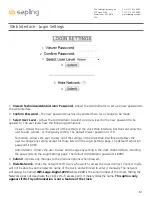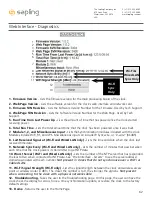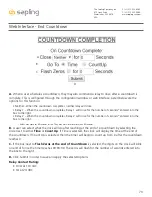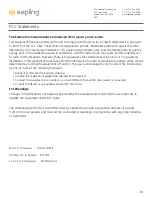
74
The Sapling Company, Inc.
670 Louis Drive
Warminster, PA 18974
USA
P. (+1) 215.322.6063
F. (+1) 215.322.8498
www.sapling-inc.com
Frequently Asked Questions
VERY IMPORTANT:
CONFIGURE YOUR CLOCK BEFORE MOUNTING IT TO A WALL OR CEILING. REFER TO THE SYNCHRONIZATION
SYSTEM SETUP SECTION OF THIS MANUAL FOR INSTRUCTIONS.
All network equipment must be powered and configured before you install the clock. If the network equipment
is not properly installed and powered, and if the clocks have not been configured to communicate with the
network equipment, the secondary clocks will not synchronize.
Will the wireless clock cause interference with other wireless devices?
No. The Wi-Fi clock operates a low-power transmitter on the 2.4GHz spectrum, and does not broadcast
often enough or powerfully enough to cause interference.
The Wireless Synchronization module, if installed, runs on either 900Mhz or 2.4GHz, depending on the part
that was ordered. This will not affect other wireless devices.
How long does it take for a clock to receive correction data?
Wi-Fi
If the clock and network are configured correctly, the clock should receive a time update within five seconds
of power up. After this, the clock will resynchronize once every five minutes by default.
IP
If the clock and network are configured correctly, the clock should receive a time update within five seconds
of power up, and once every five minutes by default after that.
Wireless
If everything is installed correctly and the transponder is open, the clock should get the signal within five
minutes. Once the clock has been synchronized, it will attempt to acquire a time signal once every minute.
Whether or not a clock actually receives a signal is dependent on the settings of the signal source. For
instance, a receiver on a locally-powered digital clock that uses a battery-powered analog clock on economy
mode as a signal source will only receive time data when the signal source transmits it—once every four
hours—even though the receiver on the digital clock listens for a signal once every minute.
GPS
If the GPS module has clear signal reception from the satellites, it will resynchronize once every minute. It
may take up to a minute to perform the initial synchronization, or longer if atmospheric conditions are bad
or if the satellites are inconveniently positioned relative to the clock.
Wired
Refer to your master clock’s manual for information pertaining to you synchronization
If the clock has more than one synchronization input (example: GPS and RS485) which one takes
priority?
The clock will update based on the most recent synchronization data it receives, regardless of the source. If
you are using more than one data input source, confirm that the sources are synchronized with each other.
Can I manually set the time on the clock?
Wired and standard Wireless clocks cannot be manually set.
Wi-Fi and cabled LAN clocks allow the user to adjust the time displayed on an individual clock through the
Web Interface. A combination of the GMT Offset and Bias Seconds options can be adjusted to set the clock
to the user’s preferred time. These options are available through the Time Settings page of the General
Settings category.





































